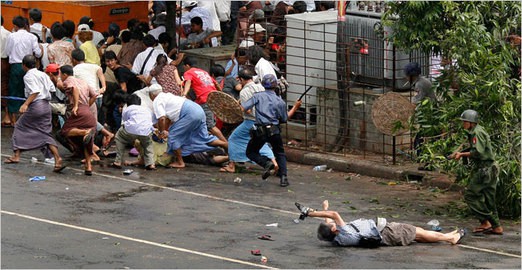Share
Shoot! Interview: Antonin Kratochvil
photo by Clay Enos Since it’s kind of photojournalism day here on the blog, and since one of the winning Pulitzer photographs this year happened ...


photo by Clay Enos
Since it’s kind of photojournalism day here on the blog, and since one of the winning Pulitzer photographs this year happened to be from Myanmar, I thought I’d post a short Q&A session I was lucky enough to have with Antonin Kratochvil. Kratochvil, if he’s new to you, is a Czech-born American photojournalist. He is also founding member of the VII Photo Agency. His career is rather epic at this point; when not in Mongolia or Iraq, he’s working on issues between the ACLU and the Department of Homeland Security, or bringing his unique style to Ray Ban or Harley Davidson. He’s also won many of these awards. And he’s a nice fellow, to boot. Below, Kratochvil answers some questions about his photographic journey.
Do you find it distracting to balance jobs that run the
gamut of the
industry- photographing Mongolian children for the Museum of Natural
History, shooting a campaign for Ray Ban, going on assignment for
Fortune, or working on a book project? Does the commercial work ever
inspire the personal work, or only vice versa?
To be honest, I don’t do much of the
commercial work. But, sometimes I miss a juicy editorial job because I am
booked on a commercial job. You have to commit. So, I don’t,
really. I enjoy different challenges. Because 70% of my work is
editorial, I only get hired for jobs that are within my main thrust, humanity
in crisis. I get hired for a kind of conflict, or social photography. 
How has the use of embedded photojournalists changed the images we see
coming from Iraq? Is there any truly objective imagery coming out of the
region now? And how do you think the embedding has changed war photography?
that’s a very long answer.
You know by being a western photojournalist in Iraq it’s very hard to
cover it,
and give a voice to the opposition. To give a complete picture of the
war in
Iraq, it’s become difficult, because the opposition hasn’t been given a
voice. And in the beginning of the war, which I covered, I was
independent. I was unilateral, so I got the other side of the
conflict, where the embedded got the view of the moving of the
forces. There were two sets of embedded photojournalists; one with
Saddam
and the other with the invading forces. A third set was unilateral,
meaning independent, and it was a very small percentage. So basically,
even though the unilateral journalists existed in Iraq during the
invasion, the Pentagon considered these people illegal and they were
subject to
arrest and deportation. I was a unilateral photojournalist in that
conflict. I didn’t want to be embedded, because I was concerned that my
opinion
would be obscured, by associating too closely with the soldiers. I
think
definitely being embedded can cloud your vision and judgment. On the
other hand it gave photojournalists unprecedented access and it was up
to their objectivity.  Antonin Kratochvil, from Iraq Documentary – January, 2006
Antonin Kratochvil, from Iraq Documentary – January, 2006
 Antonin Kratochvil, from Iraq Documentary – January, 2006
Antonin Kratochvil, from Iraq Documentary – January, 2006
The movement and abstraction that
your work is famous for is something
that’s becoming increasingly rare with the rise of digital imagery and
the tack-sharp images many editors crave. How do you preserve this look
and feel when you do shoot digitally? Have you felt pressure to change
your style?
possible to achieve the same results with digital capture. You achieve the
same result, but you have to master the new media. It takes time.
Your Myanmar prison image from 2003 is seared in my brain. Did the
actual photo meet your expectation/conception of when you shot it? Are you ever
surprised at your images when you see them?
surprise to me. I mean, I felt it, because that’s how I photograph, I
feel. People asked me how I made this picture, I don’t know how I made it,
but I felt it. A lot of my pictures are off the cuff, made through my
subconscious. 
Tell me about your involvement with Project Red. Bono has become a real
international symbol for justice; what has he been like to work with?
with Bono, is working with a man who stands for the same things as I do.
That’s it. 
photo by Antonin Kratochvil
I hear you are a big fan of the restaurant Republic. I like the salmon broth noodles. What’s your favorite dish?
‘Kay my
favorite dish is hot beef soup, and fried tofu as an appetizer. My son likes
the mint noodles, and my wife likes the duck noodles.
Yum!


